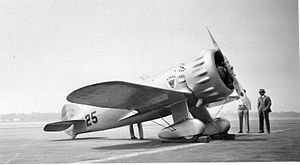
Patterson is a city in St. Mary Parish, Louisiana, United States. The population was 6,112 at the 2010 census. It is part of the Morgan City Micropolitan Statistical Area.

The Gee Bee Model R Super Sportster was a special-purpose racing aircraft made by Granville Brothers Aircraft of Springfield, Massachusetts at the now-abandoned Springfield Airport (Massachusetts). Gee Bee stands for Granville Brothers.
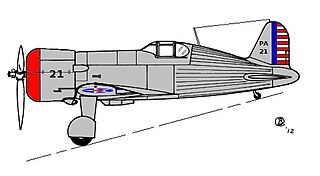
The Wedell-Williams XP-34 was a fighter aircraft design submitted to the United States Army Air Corps (USAAC) before World War II by Marguerite Clark Williams, widow of millionaire Harry P. Williams, former owner and co-founder of the Wedell-Williams Air Service Corporation.

The Hughes H-1 is a racing aircraft built by Hughes Aircraft in 1935. It set a world airspeed record and a transcontinental speed record across the United States. The H-1 Racer was the last aircraft built by a private individual to set the world speed record; most aircraft to hold the record since have been military designs.
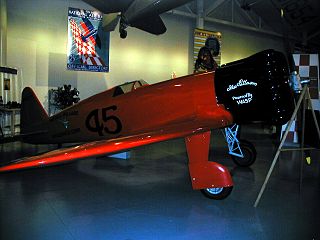
The Wedell-Williams Model 45 was a racing aircraft built in the United States in 1933.
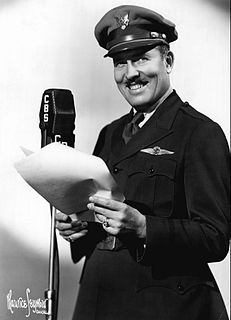
Roscoe Turner was a record-breaking American aviator who was a three-time winner of the Thompson Trophy air race and widely recognized by his flamboyant style and his pet, Gilmore the Lion.

The Howard DGA-6 was a pioneer racing plane, nicknamed "Mister Mulligan". It was the only airplane ever designed for the specific purpose of winning the Bendix Trophy. The plane was designed and developed by Ben Howard and Gordon Israel, who later became an engineer for the Grumman Aircraft Engineering Corporation. Mister Mulligan was designed to fly the entire length of the race nonstop and at high altitude. Neither had ever been done before. Mister Mulligan won the trophy, and thus changed the way in which long distance airplanes were designed.

The Macchi M.39 was a racing seaplane designed and built by the Italian aircraft company Aeronautica Macchi in 1925–26. An M.39 piloted by Major Mario de Bernardi (1893–1959) won the 1926 Schneider Trophy, and the type also set world speed records that year.

The Phantom of the Air is a 12-episode 1933 Pre-Code Universal film serial directed by Ray Taylor. The film stars Tom Tyler, who was cast most often in Westerns. Other actors include Gloria Shea, LeRoy Mason, Craig Reynolds and William Desmond.
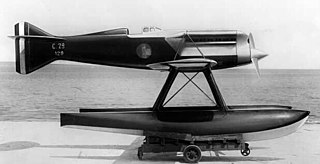
The Fiat C.29 was an Italian racing seaplane designed by Celestino Rosatelli and built in the late-1920s by Fiat Aviazione especially for the 1929 Schneider Trophy air race. Unused in the race, of the three aircraft built, two were destroyed in flying accidents while the third is on display in a museum.

The Granville Gee Bee Model Z was an American racing aircraft of the 1930s, the first of the Super Sportster aircraft built by Granville Brothers Aircraft of Springfield, Massachusetts, with the sole intent of winning the Thompson Trophy, which it did in 1931. However, it soon suffered a fatal crash during a world speed record attempt, starting the reputation of the Gee Bee aircraft as killers.

The Brown B-2 Racer was an American-built small monoplane racing aircraft built in 1934.

The Dormoy Bathtub was a simple-to-construct, high wing racing aircraft of the 1920s.
The Cessna CR-2 was a mid-winged racing aircraft in the CR series of Cessna racers.

The Folkerts SK-2, also known as Speed King Two, "Toots" and "Miss Detroit" was a racer built for the 1936 National Air Races
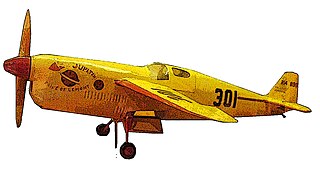
The Folkerts SK-3 a.k.a. "Jupiter, Pride of Lemont" was the third in a series of air racers developed by Clayton Folkerts.

The Laird-Turner RT-14 Meteor, also called the Turner TR-14, Ring Free Meteor, PESCO Special, Miss Champion, Turner Special and the Turner Meteor was the winning aircraft of the 1938 and 1939 Thompson Trophy races.

The Wedell-Williams Model 22 was a racing aircraft, two examples of which were built in the United States in the early 1930s by the Wedell-Williams Air Service Corporation. It was one of three early projects by aircraft designer Jimmy Wedell to create a racer and was built specifically to compete in the 1930 All-American Flying Derby from Buffalo to Detroit. It was a braced, low-wing monoplane originally powered by an inline Cirrus engine and equipped with fixed landing gear in large spats.

James Robert Wedell was a famous 1930s racing pilot and aircraft designer. Wedell broke the world record for land-plane speed in 1933 when he clocked 305.33 m.p.h. in a Wedell-Williams aircraft of his own design. He won the Thompson Trophy air race in the same year. Wedell's company, the Wedell-Williams Air Service Corporation, won 14 "distinguished finishes" in the Thompson and Bendix Trophy races.
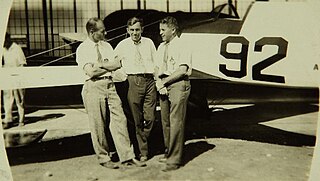
Harry Palmerston Williams was an American businessman. He was in Louisiana throughout the early years of the 20th Century. He became a noted aviation owner of the Wedell-Williams Air Service Corporation that dominated air racing in the United States during the so-called Golden Age of Aviation.
